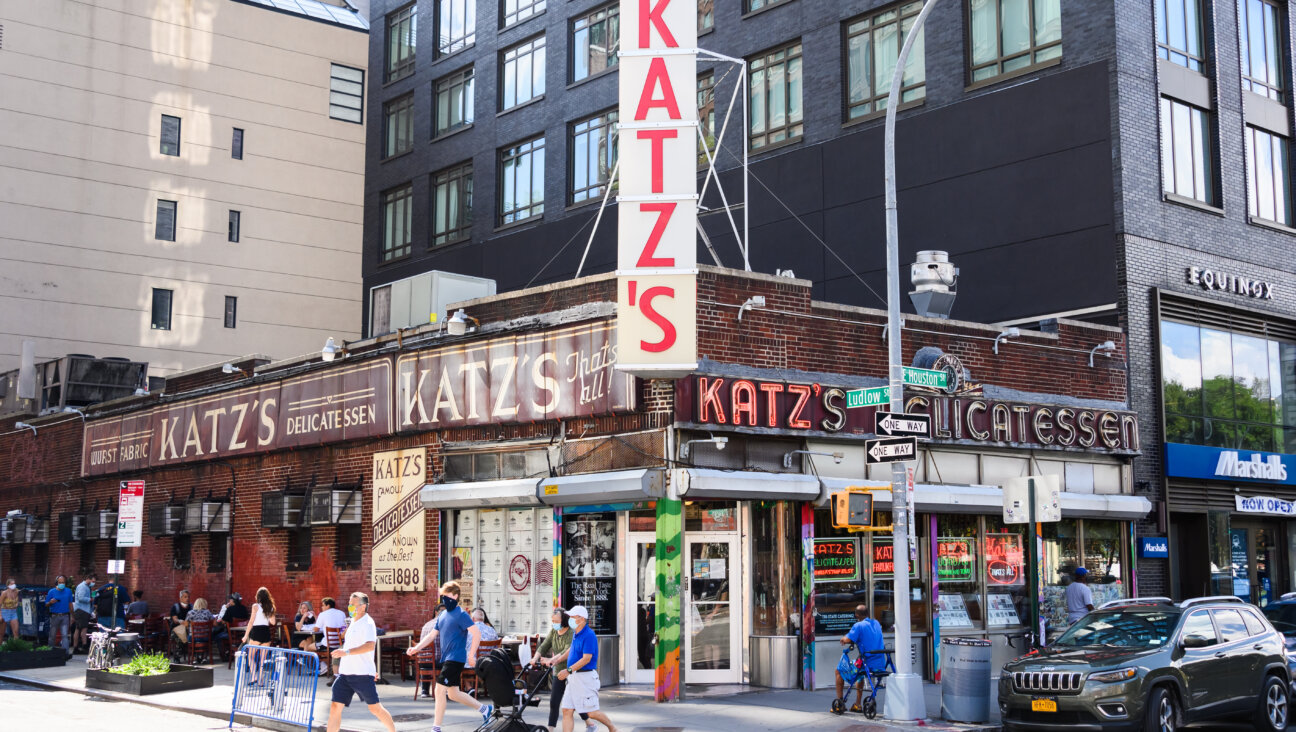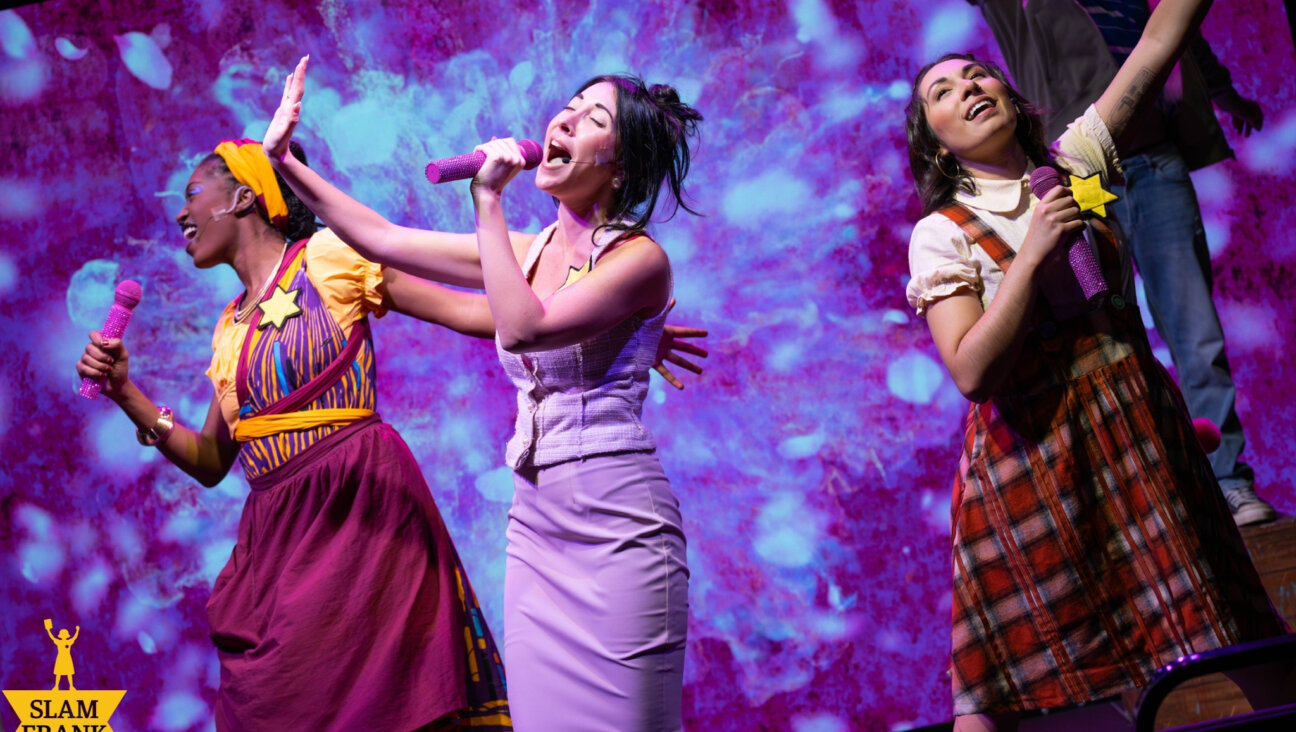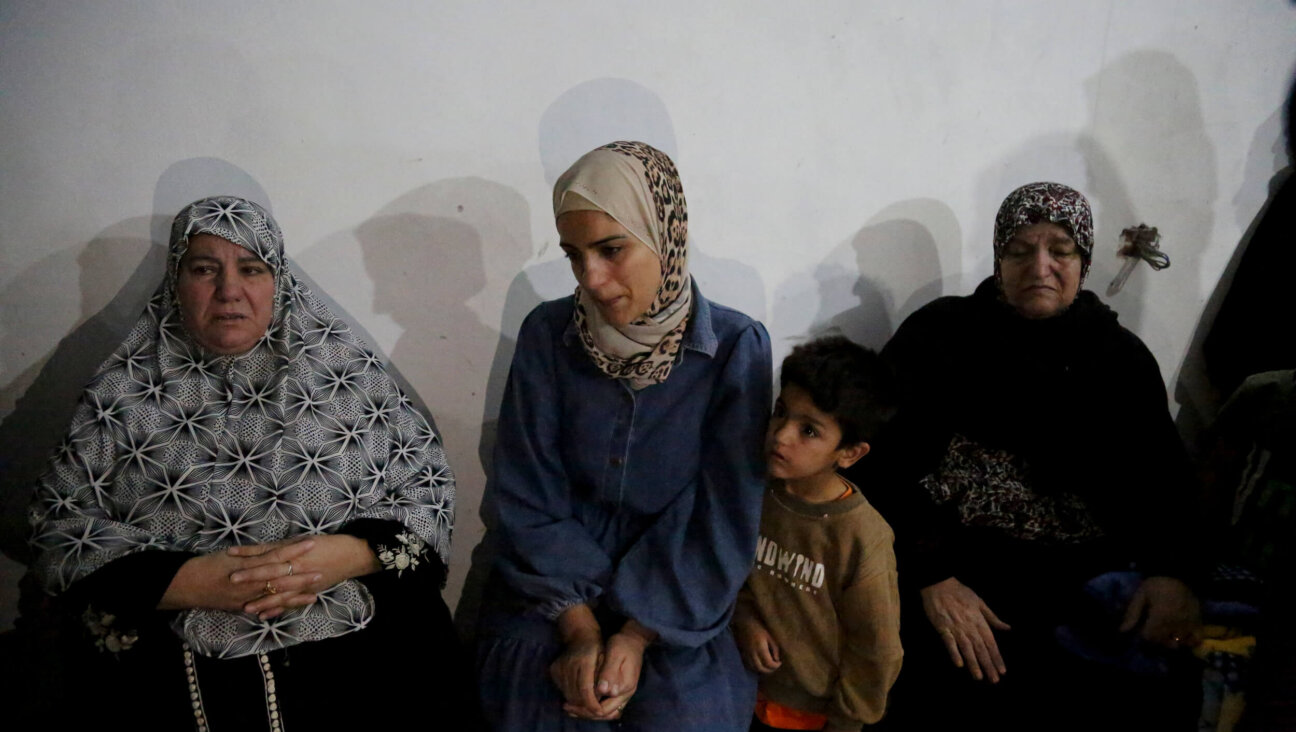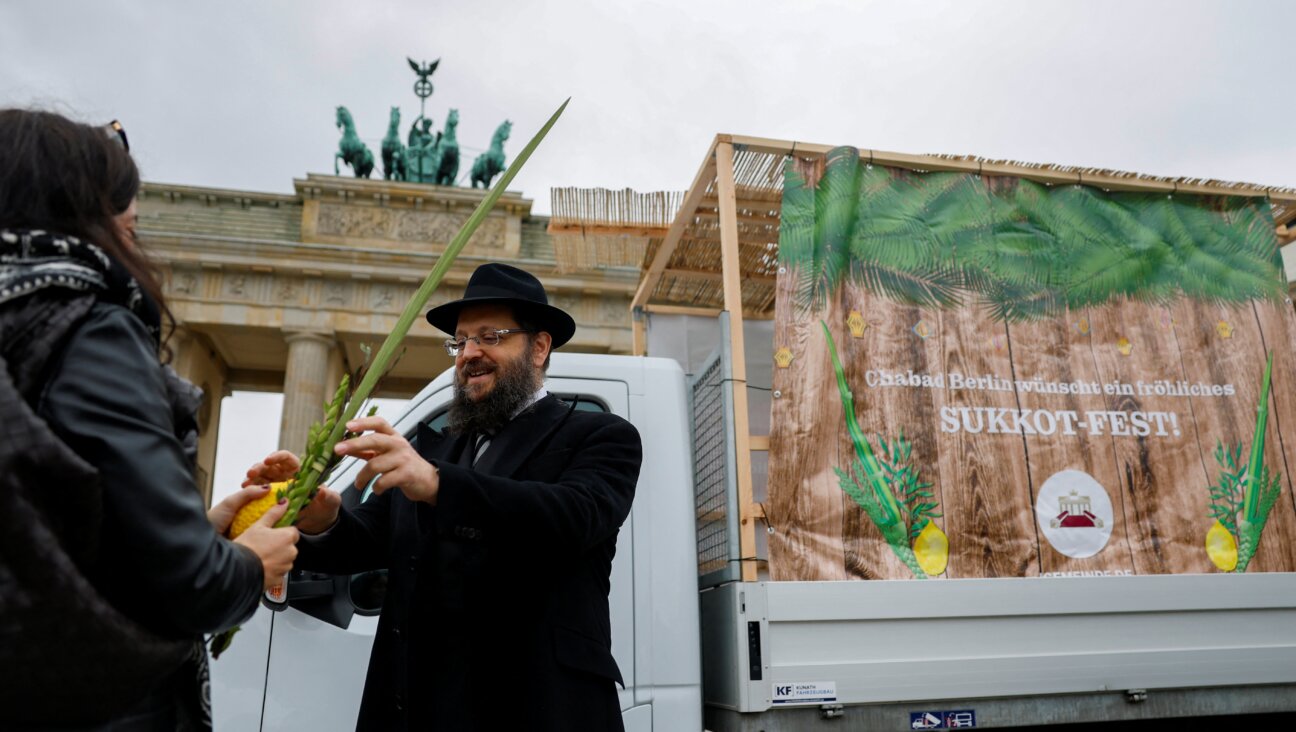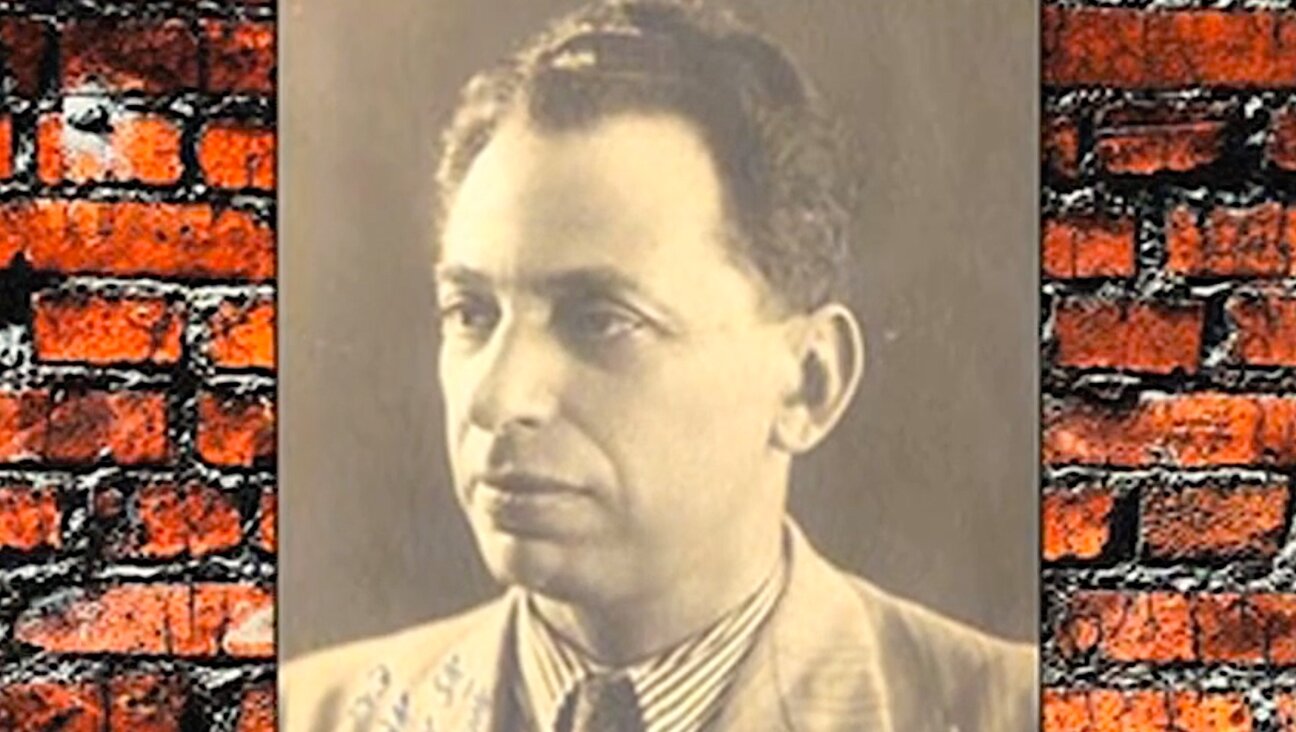With New Cookbook, Gefilteria Duo Spreads Gospel of Ashkenazi Food

Jeffrey Yoskowitz and Liz Alpern Image by Lauren Volo
Sign up for Forwarding the News, our essential morning briefing with trusted, nonpartisan news and analysis, curated by senior writer Benyamin Cohen.
Just before Passover 2012, The Gefilteria launched its artisanal line of gefilte fish. Co-founders Jeffrey Yoskowitz and Liz Alpern wanted to take gefilte fish out of the jars in the kosher aisle and gently place it on the table in a fresh and meaningful way. But the fish was just a symbol of the Ashkenazi food renaissance that these two 20-somethings were determined to nurture.
Before the fish came the idea, penned as “The Gefilte Manifesto” in 2011, and excerpted here:
…Gefilte is about reclaiming our time-honored foods and caring how they taste and how they’re sourced. It is about serving a dish with pride, not simply out of deference to hollow convention. It is about taking food traditions seriously and reclaiming the glory of Ashkenazi food — what it has been and what it can be…”
Related recipe:
As Yoskowitz and Alpern deftly navigated culinary custom and contemporary aspiration through classes, pop-up dinners and talks, over several years their audience grew. Today, they realize the next inflection point of their craft: the publication of a cookbook that will help spread the gospel of “reclaiming the glory of Ashkenazi food.”
If this sounds somewhat lofty, it is. And it has to be in order to revive an oft-maligned food tradition into a hip, tasty cuisine still rooted in history.
“The Gefilte Manifesto: New Recipes for Old World Jewish Foods,” equal parts gefilte and manifesto, provides nearly 100 recipes and the stories behind them. I caught up with Yoskowitz and Alpern over the phone last month to learn more about the book and their writing process, inspiration and culinary viewpoint. Below is that conversation, edited for length and clarity. All of the recipes discussed — mustard, borscht, challah, sour cream, butter, cholent, matzo, pickles — are in the book.
I’ve been reading through “Gefilte Manifesto” and what really struck me, and what I love, is the two voices that you each have through out the book and how you organize your storytelling. I was wondering if you could talk a little bit about how you decided to go that route, integrating two very unique, well-informed voices and playing off each other so well rather than writing the book in a single voice.
Jeffrey Yoskowitz It’s great to hear that feedback, that that worked for you. Liz and I do many demos and classes and we always have this dynamic that we enjoy and that people who come to our classes and demos feed off of. And we’re able to feed off of each other’s energy.
We initially tried writing this book from one voice, to merge our voices together, and something fell a little flat. Fortunately we have really great editors — they brought us in to the Flatiron building where Macmillan is located for a publisher-wide pickle demo. We had about 15 people come down to make pickles with us. We had so much fun with them and our editors came to us and liked how we played off each other. They said bring that energy from the workshop — the way that you fed off of each other — bring that to the book. It took us a few tries but we realized that that’s what we brought to the table.
There are so many different types of Jewish cookbooks that are out there — we have recipes that are unique and we also bring a style and our voices which are independent and unique but that together create our collective voice. So after a few drafts, we finally got to that dynamic.
I think that one of those things that define our relationship is that we get into arguments about Jewish food. I mean, we will get on the subway and debate — is there an authentic Jewish food, is cholent or matzo authentically Jewish food? And we will get into heated arguments about these things. And even about how to prepare a dish. For example, we’re making borscht in the book and there’s vinegar in the recipe, but I prefer making it a different ways, so at the end of the headnote, I say, if you want to do it my way, here’s a little trick.
Liz Alpern We’ve been working together for many years. We wrote the book and the fact that it even came about is a product of years of working together. One of the things that has defined our work is that it’s always conversational. We’re always in collaboration with our partners and with each other. Jeff is great at the detail and I have the ability to see the bigger picture. Together somehow when we bring other people into the mix, we are able to work to create really special things. The book reflects the ongoing conversation in our work and the ongoing conversation around food.
There’s this one section where you’re talking about spice levels and you pitted yourselves against each other like Hillel and Shammai [two leading 1st-Century CE sages who founded opposing schools of Jewish thought; their debates form the basis for shaping the oral law]. Amazing. Writing a book that allows a discourse like that in the context of food is so miraculous and so Jewish! The fact that there’s an audience out there than can get it, that seems to me to be reflective of where we are. Perhaps a revival of Jewish food? We’ve definitely seen it in Israeli food. Or perhaps, there’s general embracing of ethnicity and going back to one’s roots. Whatever it represents, I really felt that that little aside was so perfect for this book.
JY Wow, thank you. Yes, I do think that part of the debate and the argument is also reflective of a cultural Judaism that we both grew up with outside of New York City. Liz grew up on Long Island, I grew up in New Jersey, and we grew up learning about Hillel and Shammai. I went to college and I’m not sure if you’ve gotten to the latke-hamantashen debate section yet, but that was part of what it was like to be Jewish in America with an Ashkenazi accent. We really wanted to bring that cultural flavor and not shy away from the fact that this is an ethnic food tradition. Even though we hear around us stories of Judaism becoming bland and American and perhaps more religious and less cultural, for us, we really felt that we did have a cultural upbringing and it was really important to bring that into this book.
I remember the latke-hamantashen debate when I was in college too. For me, this type of humorous-but-deep and intellectual debate about Jewish food was a revelation but it’s now second nature to me. I kind of feel like I grew up with you guys a little bit.
LA Yeah!
JY Gayle, where did you grow up? Where’d you go to high school?
I went to a Jewish day school for elementary and then moved to an all-girls’ prep school. Even though I wasn’t at a Jewish school anymore, I also went to Jewish sleep-away camp and to Israel on a teen tour.
JY So yeah, you grew up with us.
LA It’s undeniable.
And there are all these people like us. It’s crazy to see that there’s this revival and people wanting to go more into the roots and excitement about what you guys are doing. Out of curiosity, where did each of you grow up and what was your Jewish upbringing
LA I grew up on Long Island, in Long Beach, New York. I went to public school my whole life but was in a conservative Jewish household. I went to synagogue, kept kosher at home and kosher-style out, and had a very strong sense of Shabbat practice but we would drive. It was a very classic suburban Jewish upbringing. Neither of my parents have a ton of knowledge about Judaism, but they do have that spirit. They knew enough to be interested and engaged and kept us interested and engaged. I wasn’t a big camp person, it wasn’t so organized, but Judaism was a big part of my life. I feel like this was a culture that I’m a part of, it was a very big part of my life my whole childhood.
JY I grew up in New Jersey and went to Solomon Schechter in West Orange, New Jersey —it’s now called the Golda Och Academy. I also went to a conservative Jewish synagogue and summer camp until I was fourteen, so I guess I also had a very American Jewish suburban experience. We weren’t the most religious family — we did Friday night dinner, we did the holidays, we ate kosher/vegetarian outside the house, which I think is pretty common. Because of where I went to school, I got more of a religious education and then at home I got the Yiddish education, the yiddishkeit, the cultural side. My mother’s first language was Yiddish, my father’s parents spoke Yiddish, and all my grandparents were born in Poland. That’s a difference that Liz and I have — that Liz’s family came to America before mine. All my grandparents were born in Poland; three out of four came after the war and one left before the war. So I grew up hearing accents and stories of war. That was a big part of my Jewish upbringing — the American religious stuff was one part of it, but so was the cultural side.
My father grew up in Brooklyn and would take me to the old knish bakeries and Coney Island and old delis and it was a part of our relationship. Whenever we’d come in for a Broadway show, we’d go in and get deli, or go to Ratner’s if we wanted a dairy restaurant.
It’s so funny — my mom grew up on the lower east side and she doesn’t come back very often, but when she comes back, she gets excited when she sees Yonah Schimmel’s. Sometimes my sister and I will bring knishes home for her. It’s so nostalgic.
JY We were out in San Diego for three weeks this summer doing this really cool residency at this biodynamic farm. We did a couple of dinners, one of them was basically an homage to Ratner’s, the old dairy restaurant on the lower east side. Maybe a third of the people were older Jews from the east coast who had relocated to southern California. We had baked bialys and we talked a bit, and they were so excited just to hear a New York accent. We bring a very New York energy to places when we go, and they just loved it. And they were so excited about the food. Liz and I would sit around and talk to people and they were so excited. We were able to be ambassadors from both a place but also from a time that they remembered.
How did each of you get into food? Was food something you were really passionate about early on? How did you start making your paths?
LA I got into cooking a little bit before I went to university but I went to school in Montreal, at McGill, where you don’t live in dorms. Instead you live in independent housing. So, from day one, the first day I left my parents’ house, I was making my own food and shopping, and being in a place like Montreal where people appreciate food and there are great markets and a lot of amazing ingredients. From day one, I started cooking.
I was very involved in the Jewish community and I would host a lot of meals. I would have a lot of people in my house all the time for Shabbat dinner and lunch. I didn’t grow up cooking or with a big cooking family, but I always loved to eat and I always loved holidays, so it came naturally that through hosting I started cooking a lot and experimenting and playing with different recipes all the time and cooking for crowds. I eventually started baking challah out of my apartment and selling it because there was no kosher bakery nearby but tons of people who wanted to have challah for Shabbat. That became a big part of my experience throughout out college.
I remember a lot more clearly things that I cooked and meals that I hosted and epic holiday baking than a lot of my classes. I had said to myself, “I’ll graduate college, and if I end up getting a job and I’m not so crazy about it, I should see about this food thing that I keep getting drawn to and I keep loving every time I have to cook these epic meals or bake twenty-five challahs.” So, for me, that was the beginning of it. It became part of my lifestyle and then that lifestyle grew into something that was more career-oriented. And then through circular means, I ended up working for Joan Nathan and worked at a food truck and just kept getting deeper and deeper into the food world and realizing that this was something that I was really passionate about and a place where I belonged. And the rest is history. Or at least that’s the short version.
Related:
JY For me, I guess I was always interested in food on a more intellectual, cerebral level. I remember I wrote my essay to get into college on making interesting sandwiches for lunch. Then I got to college and was a history major and remember being in a class on the American Revolution and being bored by writing an essay on taxation and I got a really bad grade. And my professor basically said, “Find something that’s more interesting to you, and you’ll write a better essay.” I remember writing an essay about tea as a symbol of the American Revolution. I got a good grade and I loved writing it, so I kept on doing that for every class. I just kept on writing about food. And that was my way of getting through college.
Then, my senior thesis in college was on the kosher food industry in the United States in the post-war period, looking at ancient dietary ritual as merging with the modern processing. And that’s really when I got deep into the supermarket and the kosher aisle. It’s interesting because when Liz and I connected about the Gefilteria, one of the things we felt was a symbol of how bad things got for Ashkenazi Jewish food was the kosher aisle — the place where Jewish food goes to die. But I — we — think that Jewish food should be celebrated
So when I graduated college, I moved on to Adamah farm on a whim. I was about to go spend a year in Israel researching the idea of food taboos then I found out about this farm where they have goats and make pickles. I started taking ideas of food and then actually learning how to farm and started to integrate those ideas into the actual acts of farming and pickling and cooking. It brought a lot together for me, and by the time I got to Israel where I was doing this other project, I was also cooking and pickling and writing. I started as a freelancer writing about these ideas of Jewish food. I came back to the US and went back to Adamah to be a pickle apprentice and helped start a pickle company. Then I came to New York and I worked at a farmers market with small growers. This was my way of transitioning form the farm to the city. Then I got involved in a company called Negev Nectars that was importing sustainably produced organic products from small growers in the Negev. [It shuttered in 2012.]
Oh, I remember that company.
JY So I was doing that and doing some writing. Around this time, David Sax had written this book “Save the Deli” and he was someone I became friendly with when I was in New York. I think one of the delis was just opening and there was a rumbling of something needing to happen, and it felt like David’s book was a call to action.
Liz and I connected around then. It was a time when we felt like this was our time. Here I was bringing food over from Israel and yet I was living in New York, so connected, so close to the place where my father grew up and to the foods where my family’s from, and it felt like something was going to be lost if we didn’t act.
We were doing all of this work in the food world in different ways and we ended up connected at an event in Washington DC where we were working with Joan Nathan and other chefs helping cook these really beautiful meals. Liz and I talked about what we wanted for a Jewish food future. That’s how we stated talking about the Gefilteria.
So, was Joan Nathan the shadchan here?
LA Maybe unintentionally. Jeffrey and I had met before in Brooklyn, and I don’t think Joan intended to set us up, but it was because of events that Joan was running — me working for her and Jeff and her connecting — and we came back together in a more serious way.
Usually when I write about cookbooks, I’ll make a few recipes that are representative of the book, and I tend to do a lot of baking. But there are so many recipes that could demonstrate what this book is about. I was thinking about the beautiful braided pumpernickel challah, but then I got caught up in this idea of all the condiments. The things you can use to add to a food to give it that Jewish flair. I never thought about making my own mustard.
LA There are a lot of reasons why we included this pantry staples chapter. First, we really love DIY projects. And part of the reason why we included this is that these are the building blocks of Ashkenazi cuisine. You don’t make your own mustard because it’s cool to make your own mustard. You make your own mustard because if you make your own knishes it tastes so much better when you have homemade mustard by its side. You can make your own cheese, because when you make your own cheese, how much better are your blintzes going to taste? We always give substitutions, we tell people you don’t have make all the pantry staples, you can purchase all of them, it’s not a big deal, but the food tastes better when you make every ingredient from scratch. And when you see those recipes, it kind of demystifies the whole process. It’s really not that difficult, it’s nothing too crazy, this is nothing that is out of the realm of someone in the kitchen. Anyone can do these things. For us, we’re so used to that kosher aisle where everything’s done for us, and so we’re really passionate about encouraging people to step back a little bit and look at the building blocks of the whole cuisine. It is amazing to make these knishes from scratch. But when you have that homemade mustard right there, you are going to be that much more rewarded. It takes, what, 10 minutes of prep time to make that mustard?
Oh, I am on it! Mustard is very important in my family.
LA I think you’ll be very happy with the results.
My mother keeps little Gulden’s mustard packs in her purse. There’s a kosher grocery store my parents like to go to in Maryland where they have a hot dog stand but they don’t have good mustard available, only that bright yellow stuff. So my dad will go and buy an entire jar of mustard from the store just to put on the one dog that he’s eating. So my mom now keeps his favorite mustard in her purse.
LA I love it.
JY That’s amazing. And that’s dedication. I’ll quickly add that I love the fact that a lot of these foods are simple, and because they’re simple, it means that all the different components need to be good. And I think something so many people always complain about with Ashkenazi food — they say, “Oh, there aren’t that many spices, it’s just potatoes and sour cream.” But I say, “Yeah, if you cook the potatoes well and add some really good sour cream, its delicious.”
There is a lot of complexity in some of these foods and a lot of these foods are fermented in various ways. We make a sour cream that’s a bit of a short cut because it’s hard to get raw milk and raw cream – we add a little cultured buttermilk to good cream — but if you were in a place where you could get really good high quality raw cream, it would be just that much better. It’s just richness at a different level.
We don’t shy away from this tradition. The point of this book is to be really proud of this tradition. It’s not just the Friendship sour cream, which we love, but part of it is getting to know, “Oh, so this is what it’s supposed to taste like.”
Are there any other recipes or ideas you think are worth getting out there that aren’t the typical recipes that people might try from your book?
LA We’re always out there trying to get people to try fermentation, whether it’s the beverages or the pickles. What can be frustrating is that those don’t always go right on the first try. It’s a process, so you have to be a tiny bit committed to getting it right.
JY One of the things we bring up a lot in the book is the idea of resourcefulness. So think of using the juice from pickles in the salad dressing. We have a fun section that’s a leftover adventure guide. So you make chicken soup, and what do you do with the leftover chicken? You make chicken salad. That’s a natural progression. We try to think about that.
Part of the goal of our book – it wasn’t just meant to be a collection of recipes – it was meant to be a give people a feeling for the cuisine and to give people a feeling of what it’s like to be in the kitchen making these foods with the leftover guide – it’s how to think Ashkenazi in the kitchen. How to think about flavors and foods and I think that’s really what we want to take away as well.
It was really important for us, when we were making foods for the Gefilteria and also working on this book, to think about finding a way to use, say, extra kasha, in another dish. Honestly, so much of what this food tradition is, is improvisational.
I feel like the food community and the Jewish food community and the food writers I know are super supportive of this book.
LA I feel really supported and everyone is on board.
JY I would say that the acknowledgment section for us is important. We felt like there were so many people both younger in the Jewish food community and older that we were able to reach out to, and we have a lot of support from people. We didn’t shy away from asking older, more famous cookbook authors or younger folks that are part of the renaissance. We feel like we’re on the front lines of a Jewish food renaissance and we’re all there helping each other out.
Related:
Gayle Squires is a food writer, recipe developer and photographer. Her path to the culinary world is paved with tap shoes, a medical degree, business consulting and travel. She has a knack for convincing chefs to give up their secret recipes. Her blog is KosherCamembert



